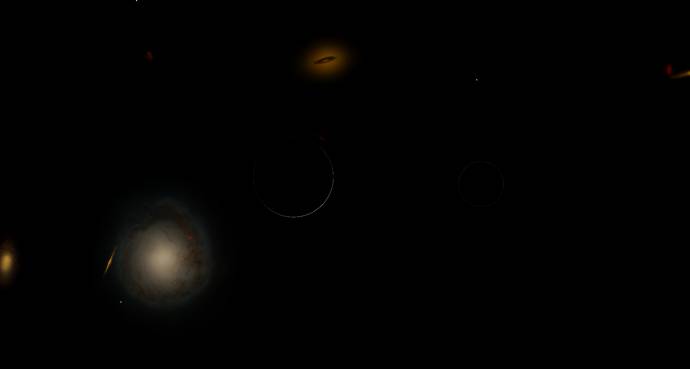|
Challenge: The Photodetective Game
|
|
| JCandeias | Date: Monday, 17.02.2014, 17:23 | Message # 106 |
 Pioneer
Group: Translators
 Portugal
Portugal
Messages: 387
Status: Offline
| I think I got it.
The terra with life orbits a brown dwarf in a close orbit, BUT... there's something else there (maybe the other half of a binary planet pair?) eclipsing part of the brown dwarf's light. That's why the lower right zone of the planet is darker than the sorrounding areas, when it shoudn't be.
The whole system orbits another, regular, star, probably a G or F dwarf.
They let me use this!

|
| |
| |
| Donatelo200 | Date: Monday, 17.02.2014, 17:54 | Message # 107 |
|
Explorer
Group: Users
 United States
United States
Messages: 261
Status: Offline
| Ok time for hints.
1. There is only one light source.
2. There is no nearby gas giant
3. Real planet brightness is on
CPU: Intel Core i7-4790K
GPU: Nvidia GTX 1080
SSD: Samsung 850 Evo 250GB
HDD: Toshiba DT01ACA200 2TB
HDD: WD Blue 1TB (2012)
RAM: Unknown 16G-D3-1600-MR 2x8GB
MBD: MSI Z97S SLI Krait Edition (MS-7922)
Edited by Donatelo200 - Monday, 17.02.2014, 17:56 |
| |
| |
| JCandeias | Date: Monday, 17.02.2014, 18:28 | Message # 108 |
 Pioneer
Group: Translators
 Portugal
Portugal
Messages: 387
Status: Offline
| Hm... in that case, the only explanation I can think of is as follows:
There's a companion planet to that terra, more or less of the same size, and probably another terra or an oceania, and we're seing the terra from the surface of that planet (or nearby). The terra is near the horizon, and the red in its disc is an atmospheric effect.
They let me use this!

|
| |
| |
| Donatelo200 | Date: Monday, 17.02.2014, 18:41 | Message # 109 |
|
Explorer
Group: Users
 United States
United States
Messages: 261
Status: Offline
| Very close but the terra is the companion and can you give me the color of said atmosphere. Its suddle but its there.
CPU: Intel Core i7-4790K
GPU: Nvidia GTX 1080
SSD: Samsung 850 Evo 250GB
HDD: Toshiba DT01ACA200 2TB
HDD: WD Blue 1TB (2012)
RAM: Unknown 16G-D3-1600-MR 2x8GB
MBD: MSI Z97S SLI Krait Edition (MS-7922)
|
| |
| |
| JCandeias | Date: Monday, 17.02.2014, 20:08 | Message # 110 |
 Pioneer
Group: Translators
 Portugal
Portugal
Messages: 387
Status: Offline
| Red?
There's a diagonal line you can see when you check the image in full scale, below which everything gets a reddish tone. Above, there doesn't seem to be any effect of the atmosphere (i.e., the clouds seem to be simply white).
They let me use this!

|
| |
| |
| Donatelo200 | Date: Monday, 17.02.2014, 21:11 | Message # 111 |
|
Explorer
Group: Users
 United States
United States
Messages: 261
Status: Offline
| Tis not red. Look in the space next to the planet. The red hue comes from light scattered through the atmosphere. The same reason the moon is red during a lunar eclipse.
CPU: Intel Core i7-4790K
GPU: Nvidia GTX 1080
SSD: Samsung 850 Evo 250GB
HDD: Toshiba DT01ACA200 2TB
HDD: WD Blue 1TB (2012)
RAM: Unknown 16G-D3-1600-MR 2x8GB
MBD: MSI Z97S SLI Krait Edition (MS-7922)
|
| |
| |
| JCandeias | Date: Monday, 17.02.2014, 21:21 | Message # 112 |
 Pioneer
Group: Translators
 Portugal
Portugal
Messages: 387
Status: Offline
| Nah. I can't see anything there.
They let me use this!

|
| |
| |
| Donatelo200 | Date: Monday, 17.02.2014, 22:45 | Message # 113 |
|
Explorer
Group: Users
 United States
United States
Messages: 261
Status: Offline
| Ah well it's green. On my screen I see the green hue just above red scattering at the bottom right. Your turn.
CPU: Intel Core i7-4790K
GPU: Nvidia GTX 1080
SSD: Samsung 850 Evo 250GB
HDD: Toshiba DT01ACA200 2TB
HDD: WD Blue 1TB (2012)
RAM: Unknown 16G-D3-1600-MR 2x8GB
MBD: MSI Z97S SLI Krait Edition (MS-7922)
|
| |
| |
| JCandeias | Date: Tuesday, 18.02.2014, 00:09 | Message # 114 |
 Pioneer
Group: Translators
 Portugal
Portugal
Messages: 387
Status: Offline
| OK, this one is rather easy by comparison to the last ones.
Who's the first to tell me what's going on here?

They let me use this!

|
| |
| |
| apenpaap | Date: Tuesday, 18.02.2014, 00:14 | Message # 115 |
 World Builder
Group: Users
 Antarctica
Antarctica
Messages: 1063
Status: Offline
| Is it a relatively weak blue star's surface (probably A-class) which is in a close binary with either a very bright blue star (O-class) or a neutron star? The companion is off to the left side, increasing the brightness of that half of it. Added (18.02.2014, 03:14)
---------------------------------------------
Actually, there's a far easier explanation: it's a fast-spinning A-star, and at the left is its pole, closer to the core due to its oblateness and therefore brighter and hotter.
I occasionally stream at http://www.twitch.tv/magistermystax. Sometimes SE, sometimes other games.
|
| |
| |
| JCandeias | Date: Tuesday, 18.02.2014, 00:25 | Message # 116 |
 Pioneer
Group: Translators
 Portugal
Portugal
Messages: 387
Status: Offline
| The right explanation was the first. The only thing wrong about it is that this is an O-class star, not A. The binary companion is also an O star.
I didn't even read the second explanation. 
Your turn.
They let me use this!

Edited by JCandeias - Tuesday, 18.02.2014, 00:25 |
| |
| |
| apenpaap | Date: Tuesday, 18.02.2014, 00:31 | Message # 117 |
 World Builder
Group: Users
 Antarctica
Antarctica
Messages: 1063
Status: Offline
| Alright, what are we seeing here?

The camera is in our own Solar System.
I occasionally stream at http://www.twitch.tv/magistermystax. Sometimes SE, sometimes other games.
|
| |
| |
| DeathStar | Date: Tuesday, 18.02.2014, 00:42 | Message # 118 |
|
Pioneer
Group: Users
 Croatia
Croatia
Messages: 515
Status: Offline
| A planet viewed with a very, very small FOV, so you can see a bunch of galaxies your normally wouldn't in the background.
Edited by DeathStar - Tuesday, 18.02.2014, 00:42 |
| |
| |
| apenpaap | Date: Tuesday, 18.02.2014, 00:52 | Message # 119 |
 World Builder
Group: Users
 Antarctica
Antarctica
Messages: 1063
Status: Offline
| With the information in the picture and the fact it was taken in our Solar System, you can give me a lot more than that.
I occasionally stream at http://www.twitch.tv/magistermystax. Sometimes SE, sometimes other games.
|
| |
| |
| JCandeias | Date: Tuesday, 18.02.2014, 01:24 | Message # 120 |
 Pioneer
Group: Translators
 Portugal
Portugal
Messages: 387
Status: Offline
| This image is very weird.
There's what DeathStar, said, but something doesn't seem to pan out with geometry. The main planet is in a very low phase, lit by a star that, according to its crescent, should be at its lower right. However, it has a secondary object to its right (not lower right; just right), that has to have the star hidden behind it, since all it shows is a very thin and very perfect circle of backscattered light. Which means an atmosphere. A pretty thin one.
It doesn't add up. 
If the main body's crescent were "pointing" to the right direction, I'd say this was the Pluto-Charon system: the relative sizes are about right, and you need to be showing very distant objects for the Sun to be completely hidden behind one of them in such a low-FOV image. Anything closer, and you'd at the very least see the corona. But with that geometry, I'm quite stumped...
They let me use this!

|
| |
| |